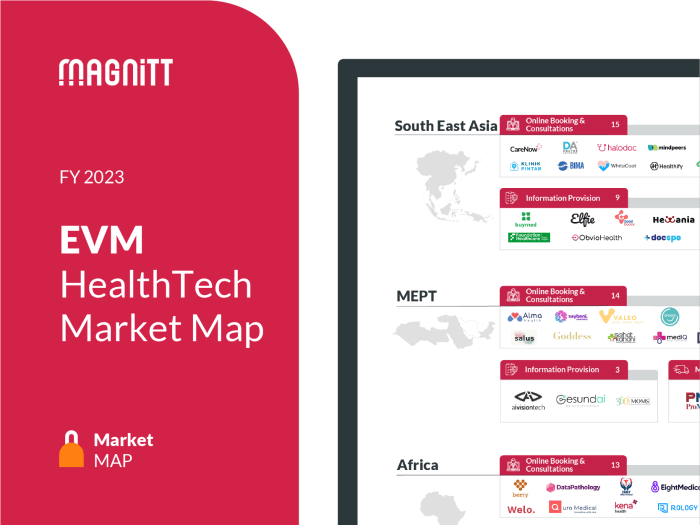Exploring the Growth of the Healthtech Market: A Comprehensive Analysis
As the healthtech market growth continues to soar, this comprehensive analysis delves into the current landscape, emerging technologies, investment trends, regulatory challenges, market opportunities, and global expansion in a manner that is both informative and engaging.
Overview of the Healthtech Market Growth

The healthtech market is currently experiencing rapid growth due to various factors driving innovation and adoption of technology in the healthcare industry. This growth is fueled by the increasing demand for digital health solutions, advancements in technology, and the need for more efficient and effective healthcare services.
Factors Driving Growth of Healthtech
- The rise of telemedicine and remote monitoring technologies, especially in light of the COVID-19 pandemic, has accelerated the adoption of digital health solutions.
- Increased focus on personalized medicine and precision healthcare, which relies on data analytics and AI algorithms to deliver tailored treatment plans for patients.
- Growing investments in healthtech startups and companies, leading to the development of innovative products and services that cater to the evolving needs of the healthcare industry.
Projected Market Size and Growth Rate
The global healthtech market is projected to reach a value of $280.25 billion by 2026, with a compound annual growth rate (CAGR) of 20.82% during the forecast period. This growth is attributed to the increasing adoption of digital health solutions, rising healthcare costs, and the shift towards value-based care models.
Emerging Technologies in Healthtech
Healthtech is rapidly evolving with the integration of various emerging technologies. Let's explore some key technologies that are transforming the healthtech sector and revolutionizing healthcare delivery.
Artificial Intelligence (AI)
- AI is playing a crucial role in healthtech by enabling predictive analytics, personalized medicine, and automation of administrative tasks.
- Machine learning algorithms are being used to analyze large datasets and identify patterns for early disease detection and treatment optimization.
- AI-powered chatbots and virtual assistants are improving patient engagement and providing instant support for basic healthcare queries.
Internet of Things (IoT)
- IoT devices, such as wearable sensors and remote monitoring tools, are allowing continuous health tracking and real-time data collection.
- Connected medical devices are enhancing patient care by enabling healthcare providers to remotely monitor vital signs and adjust treatment plans accordingly.
- IoT technology is improving the efficiency of healthcare delivery and reducing the burden on healthcare systems through proactive interventions.
Telemedicine
- Telemedicine platforms are facilitating virtual consultations, remote diagnosis, and telemonitoring, expanding access to healthcare services.
- Patients can receive medical advice, prescriptions, and follow-up care from the comfort of their homes, leading to improved convenience and patient satisfaction.
- Telemedicine is bridging the gap between patients and healthcare providers, especially in rural or underserved areas, ensuring timely access to quality healthcare services.
Investment Trends in Healthtech

Investing in healthtech companies has been on the rise as the industry continues to grow and innovate. Venture capitalists are showing a keen interest in funding startups that are developing cutting-edge technologies to revolutionize healthcare.
Successful Healthtech Startups and Funding Rounds
- 1. 23andMe - This genetic testing company has raised over $800 million in funding rounds, allowing them to expand their services and research capabilities.
- 2. Oscar Health - A health insurance startup that has secured funding of over $1.5 billion to improve the accessibility and quality of healthcare services.
- 3. Tempus - By focusing on data-driven precision medicine, Tempus has raised over $600 million to advance cancer care through technology.
Venture Capital's Role in Fueling Healthtech Growth
Venture capital firms play a crucial role in the growth of healthtech companies by providing financial support and strategic guidance. These firms invest in startups with promising technologies and innovative solutions that have the potential to disrupt the healthcare industry.
With the backing of venture capitalists, healthtech companies can accelerate their research and development efforts, scale their operations, and ultimately bring their products to market to improve patient outcomes and healthcare delivery.
Regulatory Challenges in Healthtech
The healthtech industry faces numerous regulatory hurdles that companies must navigate to bring their innovative solutions to market. Compliance with healthcare regulations is crucial to ensure patient safety, data security, and overall efficacy of healthtech products and services. Regulatory frameworks play a significant role in shaping the adoption of healthtech solutions and influencing the growth trajectory of the industry.
Challenges in Regulatory Compliance
- Stringent FDA Regulations: Healthtech companies developing medical devices or software must adhere to strict guidelines set by the Food and Drug Administration (FDA) to ensure product safety and effectiveness.
- Data Privacy Regulations: With the increasing focus on data privacy and protection, healthtech companies must comply with regulations like HIPAA to safeguard patient information.
- Interoperability Requirements: Regulatory standards for interoperability among different healthtech systems can pose challenges for companies looking to integrate their solutions with existing healthcare infrastructure.
Importance of Regulatory Compliance
- Enhancing Patient Safety: Compliance with regulations ensures that healthtech products meet quality standards and do not pose risks to patients' health.
- Building Trust: Adhering to regulatory requirements helps in building trust with healthcare providers, patients, and regulatory bodies, leading to increased adoption of healthtech solutions.
- Avoiding Legal Consequences: Non-compliance with healthcare regulations can result in legal penalties, fines, and damage to a company's reputation, affecting its growth and market presence.
Impact of Regulatory Frameworks on Adoption
- Barriers to Entry: Complex regulatory processes and requirements can act as barriers to entry for new healthtech companies, limiting competition and innovation in the industry.
- Market Access: Compliance with regulations is often a prerequisite for gaining market access and partnerships with healthcare institutions, impacting the reach and adoption of healthtech solutions.
- Standardization Challenges: Diverse regulatory frameworks across different regions or countries can hinder the global adoption and scalability of healthtech products and services.
Market Opportunities in Healthtech
Healthtech is a rapidly growing industry that offers numerous opportunities for innovation and growth. By leveraging technology, healthtech companies are revolutionizing the way healthcare services are delivered and accessed. Let's explore some of the key market opportunities in healthtech:
Niche Areas with High Growth Potential
- Telemedicine: The rise of telemedicine platforms has enabled patients to consult with healthcare providers remotely, increasing access to medical care, especially in underserved areas.
- Wearable Health Devices: The demand for wearable health devices, such as fitness trackers and smartwatches, is on the rise, offering real-time health monitoring and personalized insights to users.
- Digital Health Records: The shift towards digital health records has created opportunities for companies to develop secure and interoperable platforms for storing and sharing patient information.
Expanding Access to Healthcare Services
- Remote Monitoring: Healthtech solutions allow for remote monitoring of patients with chronic conditions, reducing the need for frequent in-person visits and improving patient outcomes.
- Mobile Health Apps: The proliferation of mobile health apps has made it easier for individuals to track their health metrics, access educational resources, and manage their well-being from anywhere.
- Virtual Consultations: Virtual consultations offer a convenient and cost-effective way for patients to seek medical advice without having to travel to a healthcare facility.
Collaboration Between Traditional Healthcare Providers and Healthtech Companies
- Integration of Technology: Traditional healthcare providers can collaborate with healthtech companies to integrate innovative technologies, such as AI-powered diagnostics and robotic surgery systems, into their practices.
- Data Sharing: Collaborations between healthcare providers and healthtech companies can facilitate secure data sharing, leading to more informed decision-making and improved patient care.
- Enhanced Patient Engagement: By partnering with healthtech companies, healthcare providers can enhance patient engagement through personalized health coaching, remote monitoring, and telehealth services.
Global Expansion of Healthtech
Global Expansion of Healthtech presents significant growth opportunities for companies in the health technology sector. As advancements in technology continue to revolutionize healthcare worldwide, the need for innovative solutions is increasing. This section will examine the international growth opportunities for healthtech companies, compare the adoption of healthtech solutions in different regions, and discuss the challenges and advantages of scaling healthtech offerings globally.
International Growth Opportunities
- Healthtech companies have the opportunity to expand their reach and impact by entering new markets across the globe.
- Collaborations with local healthcare providers and organizations can facilitate market entry and adoption of healthtech solutions in different regions.
- Emerging economies present untapped potential for healthtech companies looking to address healthcare challenges and improve access to quality care.
Adoption of Healthtech Solutions in Different Regions
- Some regions, such as North America and Europe, have been early adopters of healthtech solutions due to advanced healthcare infrastructure and regulatory frameworks.
- In contrast, developing regions in Asia and Africa are experiencing a rapid increase in the adoption of healthtech solutions to bridge gaps in healthcare delivery and improve patient outcomes.
- Cultural differences and varying healthcare systems influence the uptake of healthtech solutions in different regions, requiring companies to tailor their offerings accordingly.
Challenges and Advantages of Scaling Healthtech Offerings Globally
- Challenges include navigating complex regulatory environments, adapting to cultural differences, and establishing trust with local stakeholders.
- Advantages of scaling healthtech offerings globally include access to a larger customer base, diversification of revenue streams, and opportunities for collaboration with international partners.
- Strategic partnerships, market research, and localization strategies are essential for successful global expansion in the healthtech industry.
Ultimate Conclusion
In conclusion, the dynamic nature of the healthtech market offers a myriad of opportunities for innovation and growth. By embracing new technologies and navigating regulatory landscapes, companies can truly make a lasting impact on the future of healthcare.
Question & Answer Hub
What are the key factors driving the growth of the healthtech market?
The growth of the healthtech market is primarily driven by advancements in technology, increasing demand for remote healthcare solutions, and the need for improved efficiency in healthcare delivery.
How do regulatory frameworks impact the adoption of healthtech solutions?
Regulatory frameworks play a crucial role in ensuring the safety and efficacy of healthtech solutions, affecting their adoption rates and market penetration.
What are some niche areas within the healthtech market with high growth potential?
Niche areas such as digital health platforms, personalized medicine, and wearable health technologies show significant growth potential within the healthtech market.